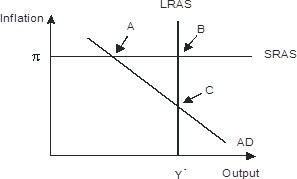A year-long drought that destroys most of the summer's crops would be considered a:
A. short-run supply shock.
B. long-run demand shock.
C. long-run supply shock.
D. short-run demand shock.
Answer: A
You might also like to view...
Refer to the figure below. In response to gradually falling inflation, this economy will eventually move from its short-run equilibrium to its long-run equilibrium. Graphically, this would be seen as
A. long-run aggregate supply shifting leftward B. Short-run aggregate supply shifting downward C. Aggregate demand shifting rightward D. Aggregate demand shifting leftward
Using productive resources to make capital goods requires that we
A) get everyone to agree on the best use of those resources. B) get government approval of our plan to make capital goods. C) forgo some level of current consumption. D) prove that the existence of the capital goods will not cause any environmental damage.
A movie costs you and your friend $15 each. After one hour of watching the movie, you have struggled to stay awake while your friend has been on Facebook and is also bored with the movie. You suggest that you and your friend leave the movie and go to the park. Your friend responds by stating that he is not going to waste his $15 that was previously spent on the movie. Your friend is considering:
A. an opportunity cost of the movie. B. the sunk cost. C. the marginal benefit. D. Total costs
Economists define capital as the
a. accumulation of goods produced in the past that are being used in the present to produce new goods and services. b. goods and services that are most affected by changes in technology. c. factors of production that can be rented by firms. d. factors of production that can be purchased by firms.